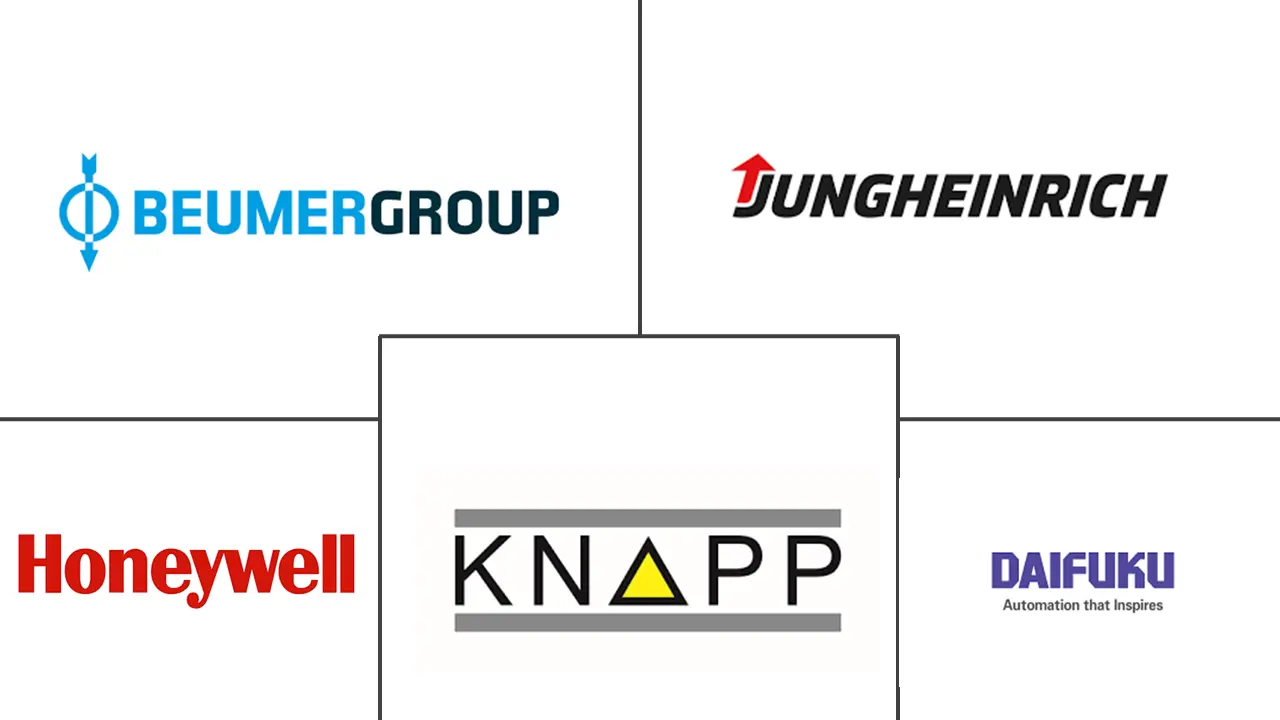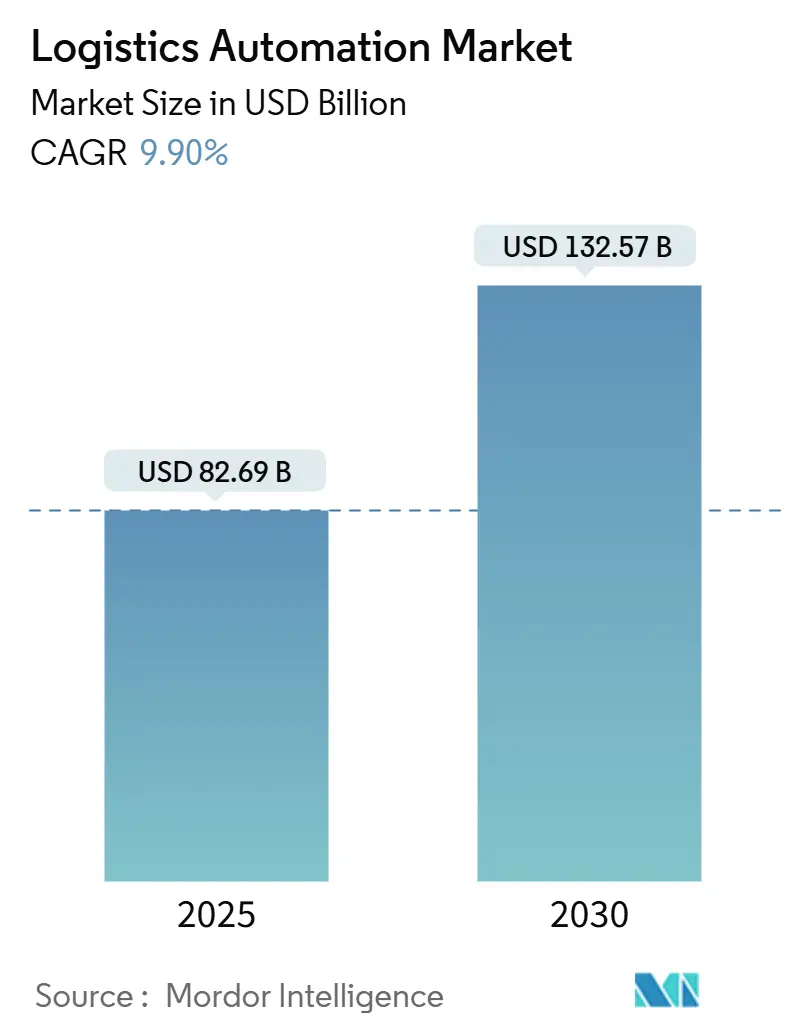
Logistics Automation Market Analysis by Mordor Intelligence
The logistics automation market size reached USD 82.69 billion in 2025 and is projected to increase to USD 132.57 billion by 2030, representing a 9.90% CAGR. Rising e-commerce parcel volumes, acute labor shortages, and expanding corporate net-zero commitments are transforming automation from a tactical option into an essential pillar of modern supply chain design. Retailers now treat automated order-fulfillment capacity as a hedge against wage inflation, while the convergence of 5G and private LTE networks inside warehouses enables real-time orchestration between robots and yard vehicles that was previously impossible. Environmental targets are also influencing capital-spending priorities, with green-bond financing increasingly tied to energy-efficient systems for picking, storage, and transport. Against this backdrop, semi-automated deployments currently dominate, but fully automated projects are scaling quickly as AI vision and functional-safety chips clear certification hurdles, thereby lowering perceived execution risk. Geographically, Asia-Pacific is rewriting the playbook: government subsidies, greenfield facility growth, and a surge in private 5G pilots are combining to make the region both the largest and fastest-growing market node.
Key Report Takeaways
- By function, warehouse automation led the logistics automation market with a 60.20% share in 2024; transportation automation is projected to advance at a 11.20% CAGR through 2030.
- By automation level, semi-automated systems accounted for 67.10% of the logistics automation market size in 2024, while fully automated deployments are projected to rise at a 10.90% CAGR through 2030.
- By end-user industry, e-commerce and parcel operations accounted for 35.60% of the revenue in 2024, whereas grocery retail is forecast to expand at a 10.60% CAGR during the same period.
- By geography, the Asia-Pacific region captured 31.20% of the logistics automation market share in 2024 and is poised to record an 11.70% CAGR through 2030.
Global Logistics Automation Market Trends and Insights
Drivers Impact Analysis
| DRIVER | (~) % IMPACT ON CAGR FORECAST | GEOGRAPHIC RELEVANCE | IMPACT TIMELINE |
|---|---|---|---|
| Rapid e-commerce parcel volumes | +2.1% | Global (Asia-Pacific core markets leading) | Short term (≤ 2 years) |
| Rising labor shortages and wage inflation | +1.8% | North America and Europe; spill-over to Asia-Pacific | Medium term (2-4 years) |
| Corporate net-zero logistics commitments | +1.5% | Global (Europe regulatory leadership) | Long term (≥ 4 years) |
| Customs-free micro-fulfillment zoning laws | +1.2% | North America and Europe; pilot programs in Asia-Pacific | Medium term (2-4 years) |
| Convergence of 5G and private-LTE networks | +0.8% | Asia-Pacific core; early adoption in North America | Short term (≤ 2 years) |
| Open-source ROS-2 maturation | +0.6% | Global, strongest in North America and Europe | Long term (≥ 4 years) |
| Source: Mordor Intelligence | |||
Rapid E-Commerce Parcel Volumes Drive Infrastructure Modernization
Fulfillment operators now face holiday-level order velocity all year, forcing a shift from batch-picking to continuous, goods-to-person flows that shrink cycle times without expanding headcount. Retailers such as Kroger deepened automation partnerships with Ocado to guarantee same-day grocery delivery service levels that manual processes cannot sustain.[1]Source: “Kroger Expands Automated Warehouses with Ocado Partnership,” Reuters, reuters.com Parallel advances in right-sizing technology enable UPS to cut packaging waste by 30% while maintaining steady throughput targets.[2]Source: “The Future of Logistics and Warehouse Automation,” UPS Supply Chain Solutions, ups.com Dense urban micro-fulfillment hubs are proliferating, and India alone is projected to reach more than 35 million ft² of such space by 2027, intensifying demand for high-cube automation capable of monetizing every cubic foot in cost-constrained city warehouses. The velocity mandate now extends to automated carton closing, labeling, and last-mile hand-off, embedding robotics across the full e-commerce workflow. Together, these forces anchor the near-term growth engine for the logistics automation market.
Rising Labor Shortages Accelerate Automation Investment Cycles
Demographic headwinds have turned labor availability into a strategic bottleneck, especially in North America and Europe. The Indian PMI reached a 16-year high in March 2024, yet integrators such as NIDO Group are rolling out unmanned goods-movement platforms for Tier 2 and Tier 3 cities, where skilled labor is scarce. Collaborative AMRs are easing the pinch: Fleet Feet reported productivity gains of 2-3× when mobile robots assumed repetitive transport chores, freeing human associates for exception handling tasks. Robotics-as-a-service contracts are rising because businesses want seasonal capacity without long-term payroll commitments. In the Asia-Pacific region, where manufacturing expansion outpaces workforce growth, these models are redefining adoption economics. The combination of constrained labor supply and flexible financing options is propelling the logistics automation market forward.
Corporate Net-Zero Commitments Reshape Facility Design Priorities
Science-Based Targets initiative pledges from global 3PLs are pushing automation that demonstrably trims energy bills and carbon footprints. Firms such as APL Logistics and Maersk now favor AS/RS that cut cold-storage power consumption by up to 40%.[3]Source: “How APAC Is Embracing Sustainable Logistics Technology,” APAC CIO Outlook, apacciooutlook.com Route-planning engines that graduate from heuristic to AI-driven optimization are reducing empty miles and aligning cost savings with emissions targets. Green bonds are unlocking capital but require auditable environmental key performance indicators, elevating data-rich automation platforms over legacy mechanization. As sustainability compliance becomes increasingly stringent, particularly in the EU, carbon-efficient automation emerges as a key criterion for warehouse upgrades, generating a new layer of demand for the logistics automation market.
Customs-Free Micro-Fulfillment Zones Enable Distributed Inventory Models
The expansion of Foreign Trade Zones in the United States enables retailers to defer duties until the point of sale, motivating them to position automated inventory closer to customers without incurring traditional bonded warehouse costs.[4]Source: “Foreign Trade Zones Program,” U.S. Customs and Border Protection, cbp.gov EU customs modernization is following suit, allowing automated hubs to serve multiple countries from a single site and recalculating duties in real-time. The regulatory shift removes legacy constraints that favored manual segregation of bonded and domestic stock, opening the door to unified high-velocity operations. Retailers that deploy automation capable of on-the-fly duty calculations gain cost and responsiveness advantages over slower rivals, further catalyzing investment across the logistics automation market.
Restraints Impact Analysis
| RESTRAINT | (~) % IMPACT ON CAGR FORECAST | GEOGRAPHIC RELEVANCE | IMPACT TIMELINE |
|---|---|---|---|
| High upfront CAPEX | −1.4% | Global; higher impact in emerging markets | Short term (≤ 2 years) |
| Integration complexity with brown-field IT | −0.9% | North America and Europe; legacy system concentration | Medium term (2-4 years) |
| Scarcity of functional-safety certified AI chips | −0.7% | Global; supply chain concentration in Asia-Pacific | Long term (≥ 4 years) |
| Rising cyber-insurance premiums for OT | −0.6% | North America and Europe; compliance-driven | Medium term (2-4 years) |
| Source: Mordor Intelligence | |||
High Upfront Capital Requirements Constrain SME Adoption
Comprehensive warehouse projects can exceed USD 5 million when structural retrofits are combined with new equipment, keeping many small enterprises on the sidelines. Pay-per-pick subscription programs, championed by AutoStore, lower grid installation costs by up to 40% but do not eliminate construction and systems integration expenses. Access to affordable financing is toughest in emerging markets that also face currency volatility, elevating perceived risk. As a result, vendors with rental or service-based models are gaining share, and larger integrators are acquiring niche robotics firms to assemble turnkey packages that are easier for lenders to underwrite. Despite progress, CAPEX remains the most stubborn near-term brake on the logistics automation market.
Integration Complexity with Legacy IT Systems Delays Implementation
Many brownfield warehouses still run 10-year-old WMS platforms that cannot provide the latency or data granularity that autonomous robots demand. Modernizing these stacks often means a full rip-and-replace, doubling timelines and budgets. Cybersecurity adds further friction: ISO 27001 requires strict segmentation between IT and OT networks, forcing extra hardware, testing, and documentation. The downstream effect is slower rollout and elevated consulting costs, particularly in North America and Europe, where legacy infrastructure is widespread. Until integrators standardize more plug-and-play middleware, this restraint will temper growth within the logistics automation market.
Segment Analysis
By Function: Warehouse Dominance with Emerging Transport Upside
Warehouse operations captured 60.20% of the 2024 revenue within the logistics automation market share, underscoring the immediate ROI companies achieve from goods-to-person pick stations, automated storage, and robotic sortation. These proven technologies thrive in controlled environments, letting retailers compress order-to-ship cycles without adding workers. Transportation automation is currently smaller but is slated for an 11.20% CAGR to 2030 as autonomous trucks and yard tractors transition from pilots to revenue service, especially along reliable freight corridors.
Continued innovation sustains warehouse leadership: AutoStore’s 2025 launch of CarouselAI delivers retrofit-friendly robotic piece-picking, enabling existing sites to scale without concrete mezzanine work.[5]Source: “AutoStore Unveils Its Latest Technology,” FinanzNachrichten, finanznachrichten.de Yet the functional boundary is blurring. Private 5G deployments at sites like CJ Logistics integrate indoor robots and autonomous yard vehicles, creating a unified data fabric that reduces dock-door congestion. Over the forecast horizon, integrated orchestration platforms could shift spending toward cross-functional solutions, but warehouses will remain the volume anchor of the logistics automation market.
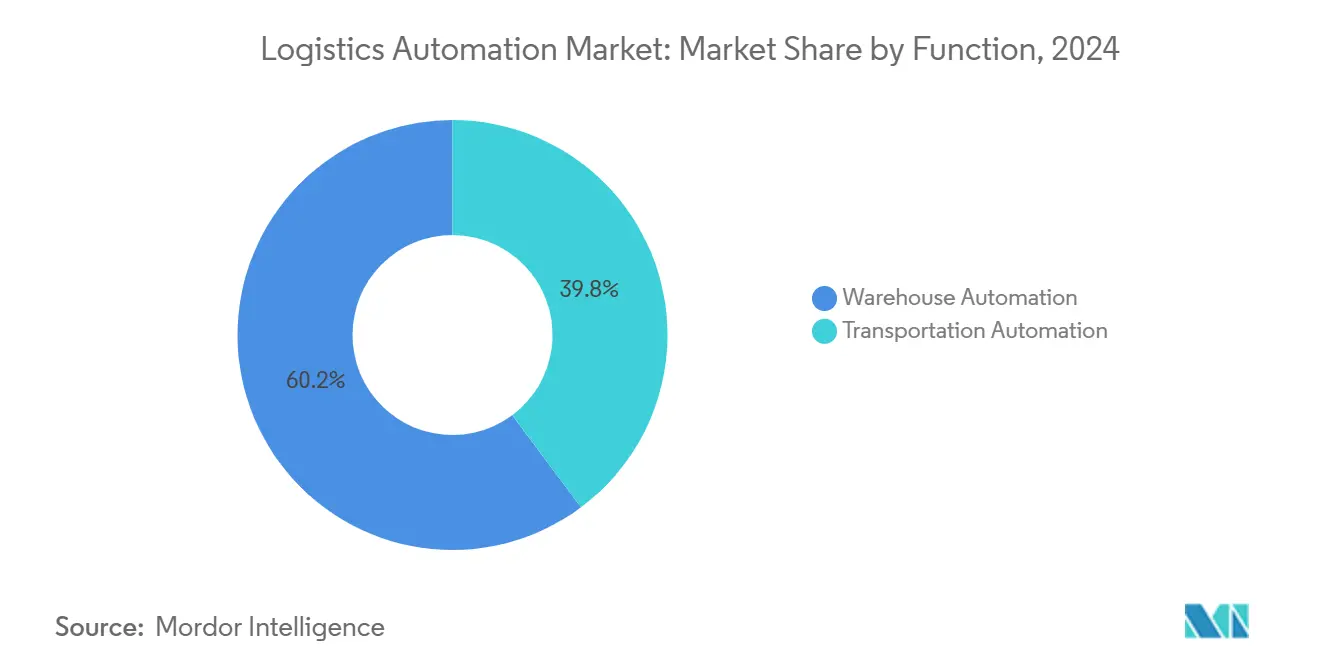
By Automation Level: Semi-Automated Today, Lights-Out Tomorrow
Semi-automated projects accounted for 67.10% of 2024 spend in the logistics automation market size, reflecting cautious adoption paths that pair robots with human oversight for exception handling. The format delivers 2-3× productivity lifts without the cultural shock of lights-out facilities, helping management secure workforce buy-in.
Fully automated systems, however, are advancing at a 10.90% CAGR, as AI vision, functional safety silicon, and advanced simulation reduce risk. Pharmaceuticals and cold-chain operations are early converts because temperature and contamination controls favor minimal human presence. Over time, falling component prices and the maturation of integration tools are expected to narrow the cost gap, drawing more operators toward end-to-end automation and propelling the broader logistics automation market.
By End-User Industry: E-Commerce Leads, Grocery Gains Momentum
E-commerce and parcel operators generated 35.60% of 2024 demand, validating their outsized influence on logistics automation market growth. Ultra-high-order velocity and irregular peaks render manual scaling unworkable, making automation a necessity.
Grocery retail is the fastest-growing vertical, with a 10.60% CAGR through 2030, driven by micro-fulfillment centers that handle frozen, chilled, and ambient SKUs under one roof. The sector lags behind general merchandise in automation adoption but is catching up quickly as consumers continue to adopt post-pandemic online buying habits. Elsewhere, manufacturing adoption remains steady but is slowing in mature economies, while apparel automation focuses on returns processing to mitigate the proliferation of SKUs. These dynamics suggest that omnichannel fulfillment pressures will continue to drive the logistics automation market into an expansionary phase.
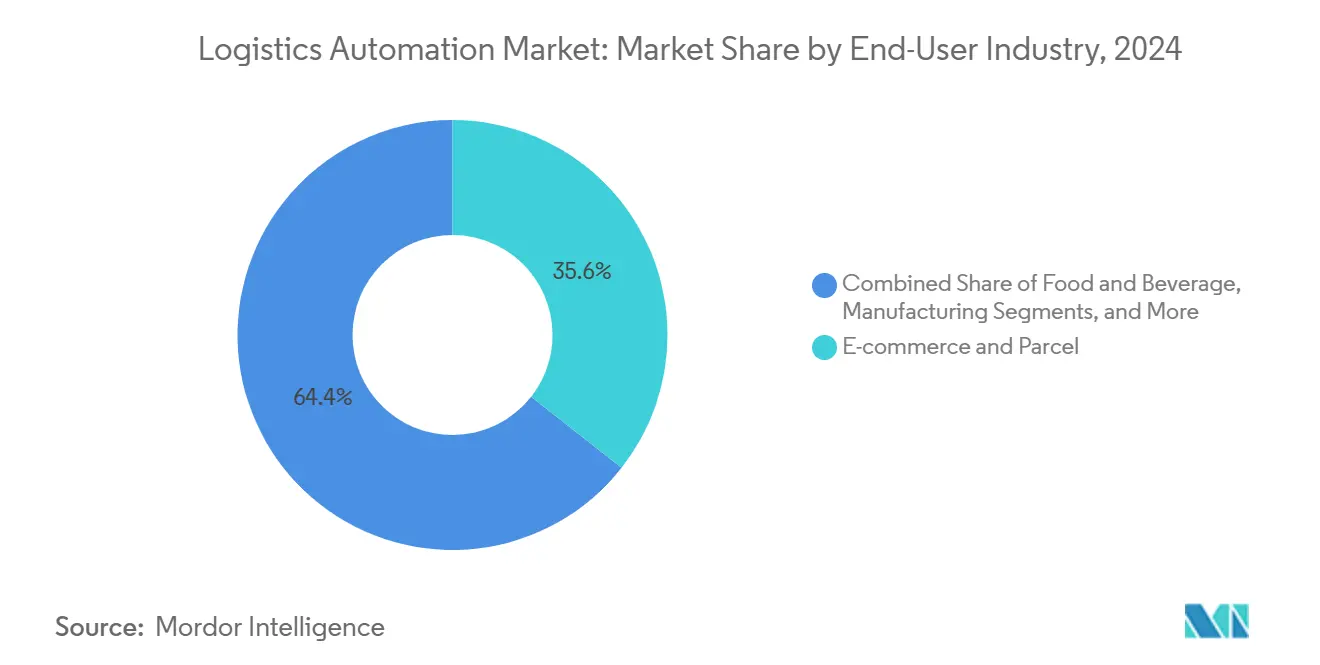
Note: Segment shares of all individual segments available upon report purchase
Geography Analysis
The Asia-Pacific region accounted for 31.20% of 2024 revenue and is projected to grow at a 11.70% CAGR to 2030, earning the region a dual distinction as both the largest and fastest-growing node of the logistics automation market. China has been the world’s top industrial-robot buyer for 11 consecutive years, producing 430,000 units in 2023 while subsidizing roughly 17.5% of equipment costs to accelerate domestic uptake. India brings complementary momentum; Grade A warehouse inventory is on track to increase from 290 million to 400 million ft² by 2027, driven by the National Logistics Policy’s push to reduce logistics costs to 10% of GDP and by surging urban micro-fulfillment demand.
North America remains a cornerstone market, thanks to high labor costs that strengthen the payback math for automation, even as complex legacy IT systems and strict cybersecurity rules lengthen project cycles. The expansion of U.S. Foreign Trade Zones supports distributed inventory strategies, freeing automated hubs from duty liabilities until final sale and sharpening cross-border e-commerce competitiveness. Europe mirrors many of these patterns, with an added regulatory premium on carbon reduction, which is funneling capital toward energy-efficient AS/RS and AI route-planning tools.
Latin America, the Middle East, and Africa are in earlier stages of adoption. Capital scarcity and limited integrator ecosystems slow headline growth, yet demographic trends and rapid e-commerce penetration outline substantial latent demand. As financing mechanisms evolve and local vendor footprints expand, these regions are positioned to become the next wave of contributors to the global logistics automation market.
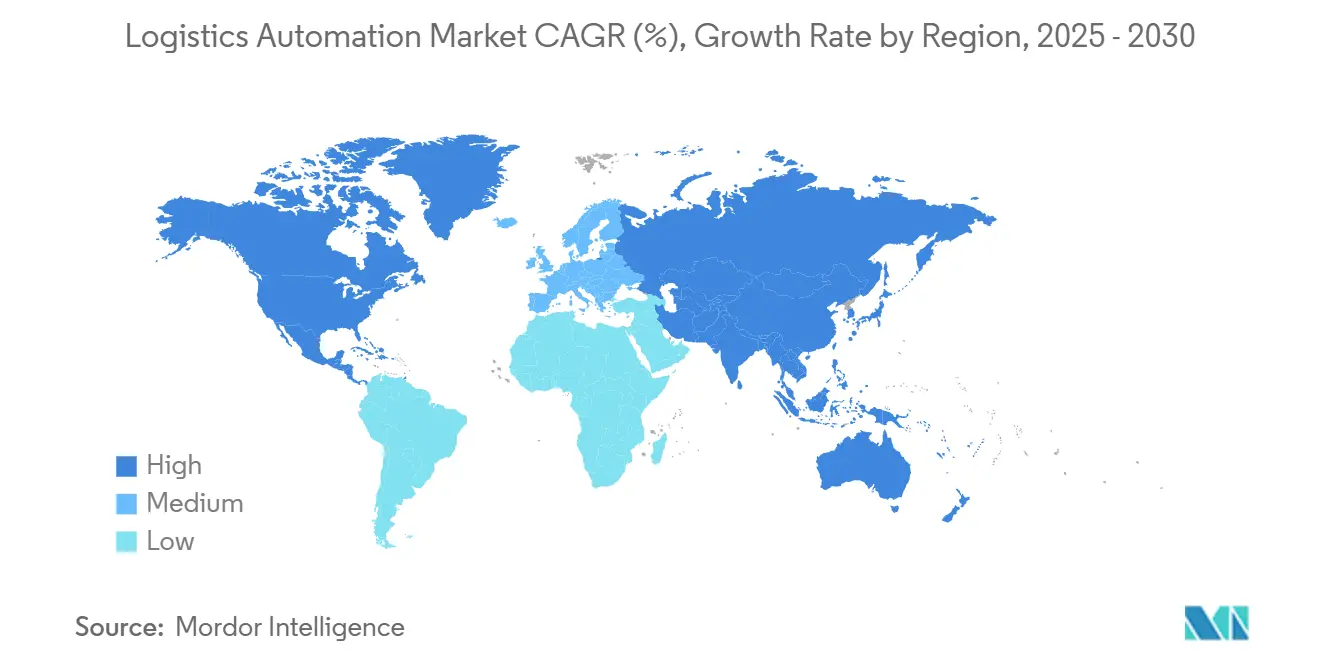
Competitive Landscape
The logistics automation market shows moderate fragmentation. European and Japanese incumbents still hold meaningful shares, but Chinese robotics producers and software-centric upstarts are pressuring price points and accelerating innovation cycles. Consolidation surged in 2024-2025: Symbotic’s USD 520 million purchase of Walmart’s robotics arm and Siemens’ USD 325 million acquisition of Vanderlande underscore the race to assemble end-to-end portfolios at a global scale.
Business models are also shifting. AutoStore’s pay-per-pick subscription demonstrates how robotics-as-a-service can lower customer CAPEX while generating vendor recurring revenue. Traditional conveyor and AS/RS companies are acquiring AMR specialists or launching internal spin-outs to avoid being disintermediated by software-first rivals. Patent activity remains dense among legacy players, yet the rise of open-source ROS-2 lowers entry barriers for smaller firms to commercialize competitive navigation and fleet-management stacks.
Functional-safety certification of AI chips has emerged as a new moat: companies such as onsemi and Axera have secured ISO 26262 ASIL B/C/D ratings, enabling deployment in safety-critical applications like autonomous forklifts. Vendors lacking certified silicon face longer validation timelines and integration risk, nudging buyers toward platforms with documented safety pedigrees. The battle for software talent, cloud-edge orchestration, and lifecycle service contracts suggests consolidation will continue as vendors chase scale, vertical integration, and global support networks to compete effectively across the logistics automation market.
Logistics Automation Industry Leaders
-
Daifuku Co., Ltd.
-
Honeywell International Inc.
-
KNAPP AG
-
Jungheinrich AG
-
BEUMER Group GmbH & Co. KG
- *Disclaimer: Major Players sorted in no particular order
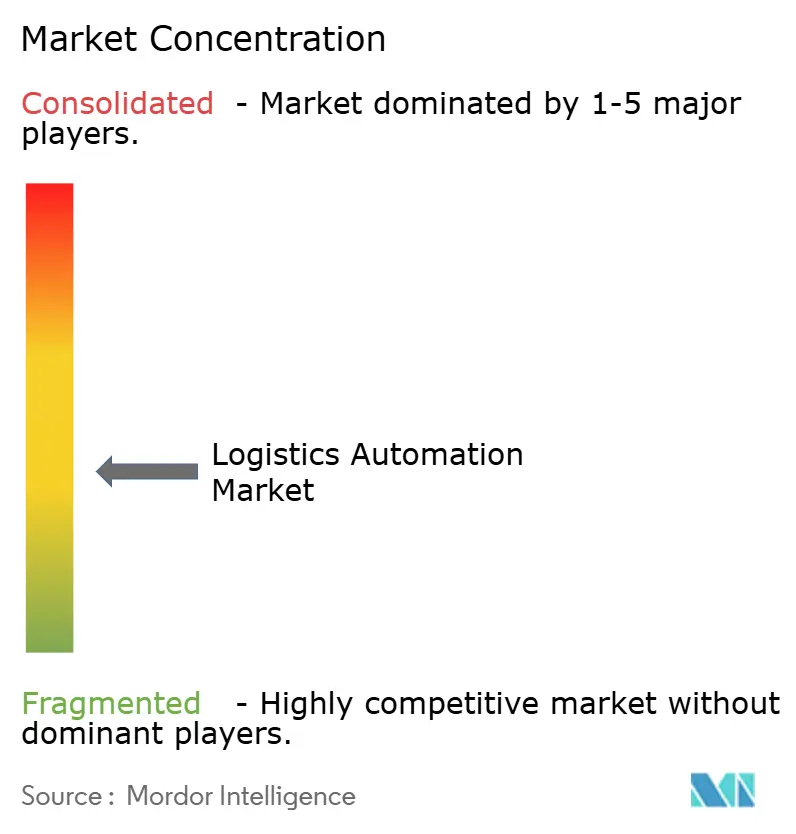
Recent Industry Developments
- March 2025: AutoStore unveiled CarouselAI robotic piece-picking solution, targeting both new builds and retrofits, with initial roll-outs in EMEA and North America.
- February 2025: GreyOrange raised USD 135 million and introduced GreyMatter-assisted picking plus Ranger and Flexo modular sortation lines.
- January 2025: BJ’s Wholesale Club confirmed a new Ohio distribution center featuring Swisslog automation, slated for a 2027 opening.
- December 2024: Symbotic finalized the USD 520 million acquisition of Walmart’s robotics business, broadening its automated-fulfillment footprint.
Global Logistics Automation Market Report Scope
Logistics automation is the use of technology like machinery and logistics software to enhance the efficiency of logistical processes from procurement to production, inventory management, distribution, customer service, and recovery.
The Logistics Automation Software Market is segmented by warehouse automation market (by component [hardware [mobile robots (AGV, AMR), automated storage and retrieval systems (AS/RS), automated sorting systems, de-palletizing/palletizing systems, conveyor systems, automatic identification and data collection (AIDC), order picking], software, and services]), by end-user industry (food and beverage, post and parcel, groceries, general merchandise, apparel, manufacturing, other end-user industries), by beography (North America, Europe, Asia Pacific, Latin America, Middle East, and Africa), and transportation automation market, other transportation automation market). The market sizes and forecasts are provided in terms of value in USD for all the segments.
| Warehouse Automation | By Component | Hardware | Mobile Robots (AGV, AMR) |
| Automated Storage And Retrieval Systems (AS/RS) | |||
| Automated Sorting Systems | |||
| De-Palletizing/Palletizing Systems | |||
| Conveyor Systems | |||
| Automatic Identification and Data Collection (AIDC) | |||
| Order Picking | |||
| Software | |||
| Services | |||
| Transportation Automation | By Component | Hardware | |
| Software | |||
| Services |
| Fully-automated Systems |
| Semi-automated Systems |
| E-commerce and Parcel |
| Food and Beverage |
| Grocery Retail |
| Apparel and Fashion |
| Manufacturing |
| Other End-user Industries |
| North America | United States | |
| Canada | ||
| Mexico | ||
| South America | Brazil | |
| Argentina | ||
| Rest of South America | ||
| Europe | Germany | |
| United Kingdom | ||
| France | ||
| Italy | ||
| Spain | ||
| Russia | ||
| Rest of Europe | ||
| Asia-Pacific | China | |
| Japan | ||
| India | ||
| South Korea | ||
| South-East Asia | ||
| Rest of Asia-Pacific | ||
| Middle East and Africa | Middle East | Saudi Arabia |
| United Arab Emirates | ||
| Rest of Middle East | ||
| Africa | South Africa | |
| Egypt | ||
| Rest of Africa | ||
| By Function | Warehouse Automation | By Component | Hardware | Mobile Robots (AGV, AMR) |
| Automated Storage And Retrieval Systems (AS/RS) | ||||
| Automated Sorting Systems | ||||
| De-Palletizing/Palletizing Systems | ||||
| Conveyor Systems | ||||
| Automatic Identification and Data Collection (AIDC) | ||||
| Order Picking | ||||
| Software | ||||
| Services | ||||
| Transportation Automation | By Component | Hardware | ||
| Software | ||||
| Services | ||||
| By Automation Level | Fully-automated Systems | |||
| Semi-automated Systems | ||||
| By End-user Industry | E-commerce and Parcel | |||
| Food and Beverage | ||||
| Grocery Retail | ||||
| Apparel and Fashion | ||||
| Manufacturing | ||||
| Other End-user Industries | ||||
| By Geography | North America | United States | ||
| Canada | ||||
| Mexico | ||||
| South America | Brazil | |||
| Argentina | ||||
| Rest of South America | ||||
| Europe | Germany | |||
| United Kingdom | ||||
| France | ||||
| Italy | ||||
| Spain | ||||
| Russia | ||||
| Rest of Europe | ||||
| Asia-Pacific | China | |||
| Japan | ||||
| India | ||||
| South Korea | ||||
| South-East Asia | ||||
| Rest of Asia-Pacific | ||||
| Middle East and Africa | Middle East | Saudi Arabia | ||
| United Arab Emirates | ||||
| Rest of Middle East | ||||
| Africa | South Africa | |||
| Egypt | ||||
| Rest of Africa | ||||
Key Questions Answered in the Report
How large is the global logistics automation market in 2025?
The logistics automation market size stands at USD 82.69 billion in 2025 and is projected to reach USD 132.57 billion by 2030.
Which segment currently holds the biggest share of automation spending?
Warehouse operations lead with 60.20% of 2024 revenue, reflecting rapid ROI from goods-to-person, AS/RS, and robotic sortation solutions.
What region drives the fastest growth?
Asia-Pacific combines the largest 2024 share (31.20%) with the highest forecast CAGR (11.70%), thanks to subsidies, greenfield sites, and 5G rollouts.
Why are grocery retailers accelerating automation adoption?
Online grocery demand and micro-fulfillment center models require temperature-controlled, high-throughput picking that manual methods cannot support, yielding a 10.60% CAGR to 2030.
How are companies mitigating high CAPEX barriers?
Robotics-as-a-service subscriptions, green bonds, and vendor-financed packages are lowering upfront costs and shifting spending to operational budgets.
What technology trend will most influence future deployments?
The merging of private 5G networks with warehouse AMRs will enable real-time orchestration between indoor robots and autonomous yard vehicles, unlocking end-to-end optimization.
Page last updated on:
